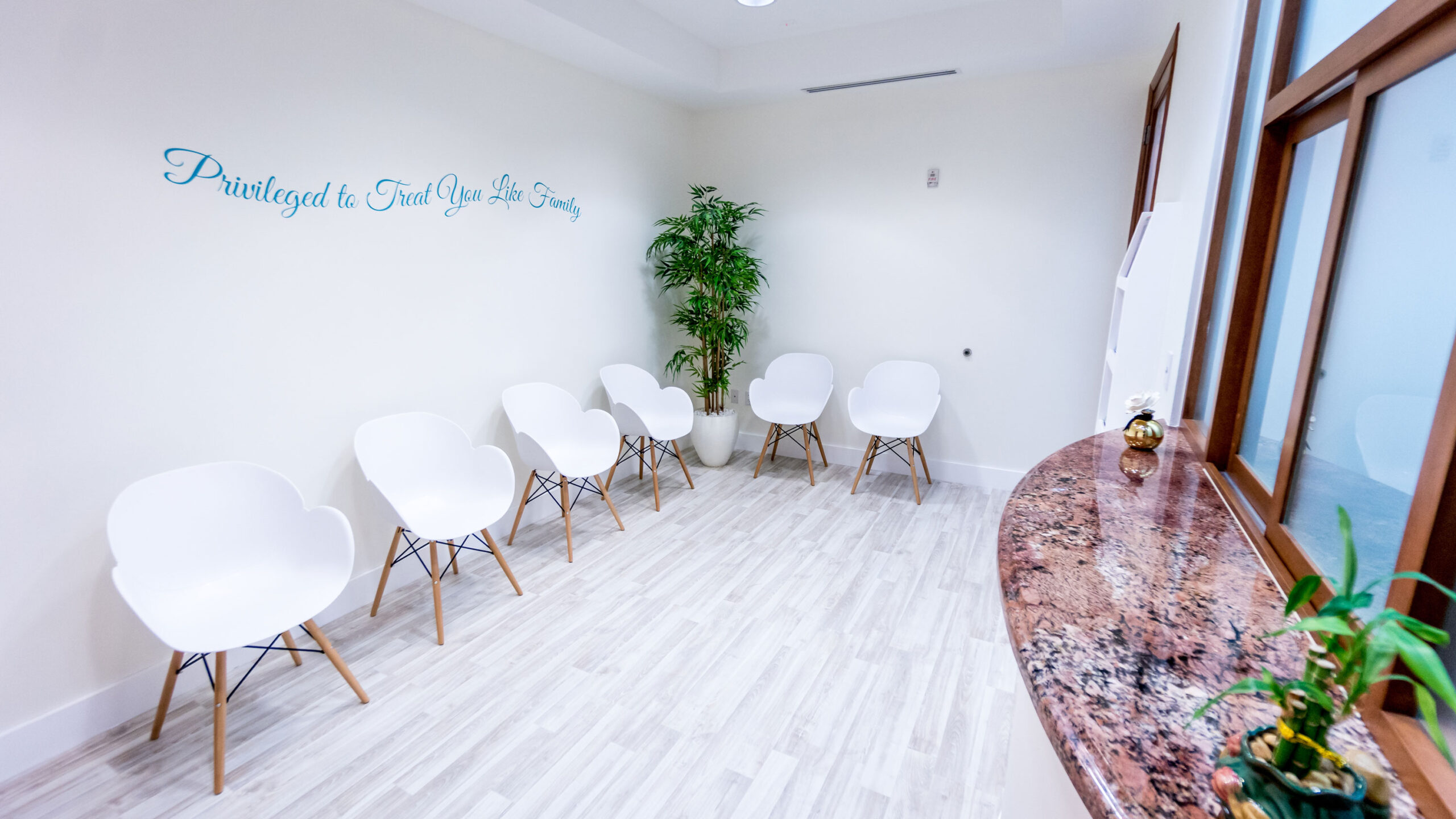Your general dentist in Kendall. Privileged to treat you like family!
Invisalign Treatment Summary
- Invisalign is a modern orthodontic solution that straightens teeth discreetly and comfortably using custom-fitted clear aligners.
- The benefits of Invisalign include discreet teeth straightening, a comfortable and customized fit, and easy oral hygiene maintenance, resulting in a transformed smile and boosted self-confidence.
- Ideal candidates for Invisalign include individuals with minor to moderate dental misalignments seeking a more aesthetic and convenient alternative to traditional braces.
- The Invisalign treatment process involves taking an impression of the patient’s mouth, creating custom aligners, and switching to a new aligner every couple of weeks, with checkups scheduled once a month or every month-and-a-half.
- Invisalign treatment costs in Kendall, FL, depend on the complexity of the dental issues and the duration of the treatment plan.
- After completing Invisalign treatment, patients are advised to wear retainers to maintain their newly straightened teeth and prevent them from shifting back to their original positions.
Achieving a beautifully aligned smile is now possible without the discomfort and visibility of traditional metal braces, thanks to Invisalign. Dr. Andy Gaertner offers this innovative treatment at Bliss Dental to help patients achieve the smile they’ve always wanted.
Teeth-Straightening Benefits from an Invisalign Dentist
Invisalign offers a contemporary orthodontic solution that not only straightens teeth discreetly but also improves oral health and enhances your self-confidence. When it comes to achieving a truly transformative smile, the benefits are evident.


What is Invisalign?
Invisalign is an innovative system that offers a modern solution to traditional braces for tooth alignment. This orthodontic treatment uses clear plastic aligners, also known as Invisalign trays, which are practically invisible and custom-fitted to gradually shift your teeth into their proper alignment. Unlike traditional metal braces that use metal wires and brackets, Invisalign aligners are removable, allowing for better oral hygiene and no dietary restrictions.
Invisalign is an excellent choice for many patients with minor to moderate orthodontic issues. However, not everyone is a good Invisalign candidate. Some cases of misaligned teeth may require more traditional treatment options.

Should I Get Invisalign?
Invisalign is an excellent option for individuals seeking a subtle, comfortable, and convenient solution to straighten their teeth. However, it is essential to consider the benefits and limitations of Invisalign compared to traditional braces before deciding on the best treatment for your specific needs.
What Happens if I Don’t Fix Crooked Teeth?
Leaving crooked teeth untreated can result in several dental issues, including irregular wear patterns, chipping, temporomandibular joint disorder (TMJ or TMD), and difficulties in maintaining proper oral hygiene. In addition, crooked teeth can negatively impact a person’s self-esteem and overall appearance.
Best Invisalign Candidates in Kendall, FL
Invisalign is generally recommended for patients with minor to moderate dental misalignments. Dr. Andy Gaertner at Bliss Dental in Kendall, FL, can evaluate your specific dental needs to determine if Invisalign is the right choice for you. Learn more about using Invisalign for crowns and veneers in complex situations.
The Invisalign Dentist Consultation
During your Invisalign consultation with Dr. Gaertner, he will assess your dental health and discuss your specific needs and goals. He will determine if Invisalign is the appropriate treatment for you and provide an estimate of the treatment duration, costs, and payment options. This is an excellent opportunity to ask any questions you may have about the Invisalign treatment process and what to expect during your journey to a beautifully aligned smile. If you’re weighing your options, learn more about choosing between Invisalign and porcelain veneers.

The Invisalign Treatment Process
The Invisalign treatment process is a comprehensive journey that involves several key steps. This innovative system, offered by Dr. Andy Gaertner at Bliss Dental in Kendall, FL, uses clear trays to gradually shift your teeth into their desired positions. The process includes:
- An initial consultation with the Invisalign dentist to assess your dental health and discuss your specific needs and goals.
- Taking an impression of your mouth to create a 3D replica of your bite and tooth alignment.
- Creating custom Invisalign aligners tailored to your unique needs.
- Switching to a new set of aligners every couple of weeks.
- Scheduling checkups once a month or every month-and-a-half to make sure your teeth are moving in the intended pattern.
How to Handle Cracked Aligners
Although Invisalign aligners are designed for durability and comfort, it’s essential to handle them with care. In rare cases, patients may encounter issues like cracked Invisalign aligners. If you notice any cracks or damage to your aligners, please contact Dr. Gaertner as soon as possible. Continuing to wear a damaged aligner can impact the treatment process and may cause discomfort.
At Bliss Dental, we are dedicated to making sure your Invisalign treatment progresses smoothly, and we’re available to address any concerns or unexpected situations that may arise.
Call today to schedule your consultation
Recovering After Invisalign Treatment
Once the Invisalign treatment is complete, it’s essential to maintain the newly straightened teeth to prevent them from shifting back to their original positions. Dr. Gaertner may recommend using retainers, either permanently glued or removable, to enforce the new alignment and provide long-term correction. These retainers can be worn while sleeping to promote the continued stability of the teeth in their proper positions.
By following Dr. Gaertner’s recommendations and maintaining good oral hygiene practices, patients can enjoy the lasting benefits of a beautifully aligned smile after completing their Invisalign treatment.

Cost of Invisalign in Kendall, FL
Invisalign treatment costs can vary depending on the complexity of the dental issues and the duration of the treatment plan. While the cost of Invisalign may be higher than with traditional metal braces, it offers several advantages, including faster results, fewer scheduled visits, and a more discreet appearance.
Dr. Gaertner’s team at Bliss Dental in Kendall, FL, can provide a detailed estimate after the consultation and discuss your options to help you make an informed decision.

Teeth-Correcting Invisalign Results
The Invisalign treatment is effective for correcting a range of dental misalignments, including overcrowded, gapped, or crooked teeth. Patients who undergo Invisalign treatment with Dr. Gaertner at Bliss Dental in Kendall, FL, can expect to see noticeable improvements in their smile as the treatment progresses.
By following the customized treatment plan and maintaining good oral hygiene practices, patients can enjoy the lasting benefits of a straight and confident smile after completing their Invisalign treatment.
Helpful Related Links
- American Dental Association (ADA). Glossary of Dental Terms. 2015
- American Academy of Cosmetic Dentistry® (AACD). Home Page. 2015
- WebMD. WebMD’s Oral Care Guide. 2015
Why Choose Dr. Gaertner for Invisalign in Kendall, FL?
Dr. Andy Gaertner, a highly skilled and experienced dentist in Kendall, FL, is dedicated to providing patients with the highest level of care when it comes to Invisalign treatment. By choosing Dr. Gaertner for your Invisalign treatment, you can expect the following:
- Personalized treatment plans tailored to your unique needs and goals.
- A comfortable, state-of-the-art facility equipped with advanced dental technology.
- A strong commitment to patient satisfaction and safety.
- Expertise in various types of Invisalign treatments, offering the best possible results.
Trust your Invisalign journey to Dr. Gaertner and his team at Bliss Dental, who are committed to helping you achieve a beautifully aligned smile.



